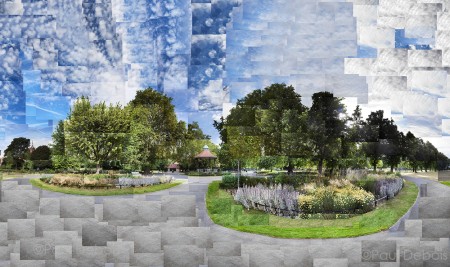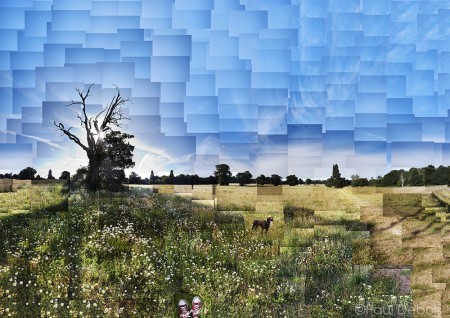One of the unusual jobs I did last year was to produce three photo montages for SAGA, illustrating parks that had been restored using lottery grant money. Actually it was one of those jobs that was great fun to do because the brief was very open. I had free range over the interpretation, providing each image was identifiable with each of the respective sites. A rarity! The parks in question were Myatt’s Field in Lambeth, London, Catton Park near Norwich, and Sandall Park near Doncaster.
Due to the hot weather in early July 2010, the time scale for shooting was short. Grass was burning up and flower displays were quickly going over. So immediately after the press day of the Hampton Court Flower Show, I headed up to Norwich at the start of a long three day circular journey.
The ambient lighting or weather conditions are the same in any montage I have made – stable! It can be overcast, rainy or sunny. I don’t care. Anything but changeable. Ideally you want the same lighting from the first frame to the last, otherwise it makes it very difficult to join the images together once working on the computer. I now always shoot this type of image with a digital camera. The first ones I made whilst at college in the early 1980’s were obviously on film and were much smaller scale – they were rarely more than 20-30 individual photographs arranged together. The ones I now produce can have anything from 200 up to 600 individual frames. With this number, you have to have similar contrast and colour balance.
Even with 600 images, speed is still needed. The basic set will be produced in around 60 minutes, with maybe additional key shots taken immediately afterwards. I never use a tripod, as I’m not trying to get a symmetrical line of frames for a seamless join. Actually, human error is a key part. One small aberration at the left of the frame will have a knock on effect on the right and vice versa. But this is part of the adventure. It creates distortions – and the fact that the angle of views are often 240 degrees to 360 degrees, perspectives are deliberately false.
Underneath each image is a link which will reveal an animation in a new window, showing the construction of the photograph, from the first frame to last.
Myatt’s Fields – click to view animation
Catton Park – click to view animation
Sandall Park – click to view animation
My first montages were made from SX-70 Polaroids. They were slightly easier to join up as the prints were produced instantly and you knew immediately whether you needed to shoot more frames to complete the set. The following are made up from only four shots each.
With these images, I scratched the surface with sand paper as an experiment to reduce the gloss finish. I even remember setting fire to some to see what distortion effects I could achieve. Not normal practice, and I remember as a sheepish 19 year old trying to explain what the burning smell was to my mother. For those who are curious, they smell like burning car tyres!
The following sequence is from more recent work.
Kew Montage 2 was in the New Views Exhibition at Kew Gardens in 2004. Trafalgar Square and M40 Junction 6 appeared in the Garden Photographer of the year exhibitions in 2007 and 2008 respectively.
The parks images can be seen in the March issue of SAGA Magazine.








